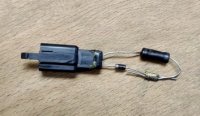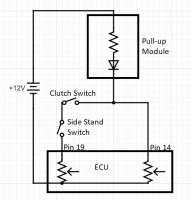Stephan Schmitz-Justen
Just got it firing!
Hey Guys!
New to the Forum and new to Guzzis! I just got a custom V7 and I am redoing some of the messy wiring the previous owner left behind and I stumbled upon a burnt up pull-up resistor as seen in the image below.


When took it out of the heat shrink I could see that the part is simply a small diode and a larger resistor. The diode is fine and I was able to get a measurement of 220 Ohms from the resistor, but I believe this to be too little and I was not able to find the information on the resistance elsewhere on the web. Due to the resistor being burned, I cannot assume that the resistance is correct and cannot read the part number on the piece to look it up.
I do not wan't to pay the 50ish dollars for a new piece (Part number 887948) if I can replace just the resistor for maybe a dollar or two. I was wondering if anyone would be willing to look at their part and see if you can read the information on the resistor or measure it. If you cannot read it and have to measure it you would need to take off the heat shrink.
I think it would be great to have the information for the pull-up module on the forum so no one has to shell out 20x what it costs to make the part.
New to the Forum and new to Guzzis! I just got a custom V7 and I am redoing some of the messy wiring the previous owner left behind and I stumbled upon a burnt up pull-up resistor as seen in the image below.


When took it out of the heat shrink I could see that the part is simply a small diode and a larger resistor. The diode is fine and I was able to get a measurement of 220 Ohms from the resistor, but I believe this to be too little and I was not able to find the information on the resistance elsewhere on the web. Due to the resistor being burned, I cannot assume that the resistance is correct and cannot read the part number on the piece to look it up.
I do not wan't to pay the 50ish dollars for a new piece (Part number 887948) if I can replace just the resistor for maybe a dollar or two. I was wondering if anyone would be willing to look at their part and see if you can read the information on the resistor or measure it. If you cannot read it and have to measure it you would need to take off the heat shrink.
I think it would be great to have the information for the pull-up module on the forum so no one has to shell out 20x what it costs to make the part.

